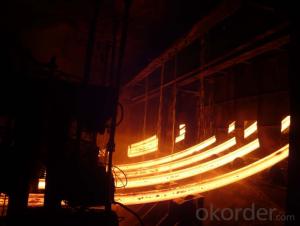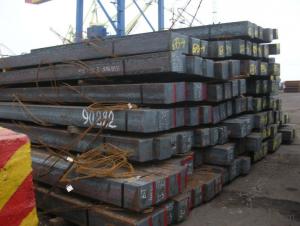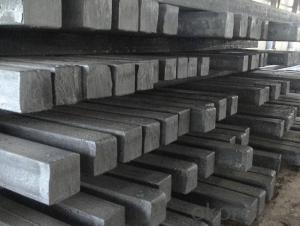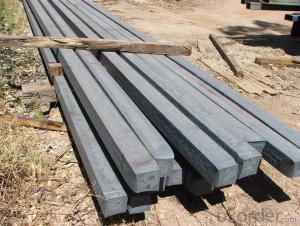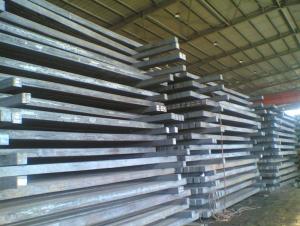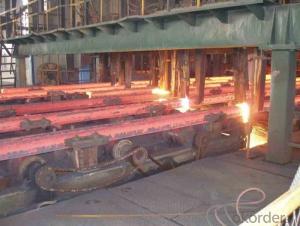Hot Rolled Square Steel Billet 3SP Standard 175mm
- Loading Port:
- Shanghai
- Payment Terms:
- TT OR LC
- Min Order Qty:
- 2000 m.t.
- Supply Capability:
- 10000 m.t./month
OKorder Service Pledge
OKorder Financial Service
You Might Also Like
Structure of Hot Rolled Square Steel Billet 3SP Standard 175mm

Description of Hot Rolled Square Steel Billet 3SP Standard 175mm
PPGI is made by cold rolled steel sheet and galvanized steel sheets as baseplate, through the surface pretreatment (degreasing, cleaning, chemical conversion processing), coated by the method of continuous coatings (roller coating method),
and after roasting and cooling. Zinc coating: Z60, Z80, Z100, Z120, Z180, Z275, G30, G60, G90
Alu-zinc coating: AZ60, AZ80, AZ100, AZ120, AZ180, G30, G60, G90
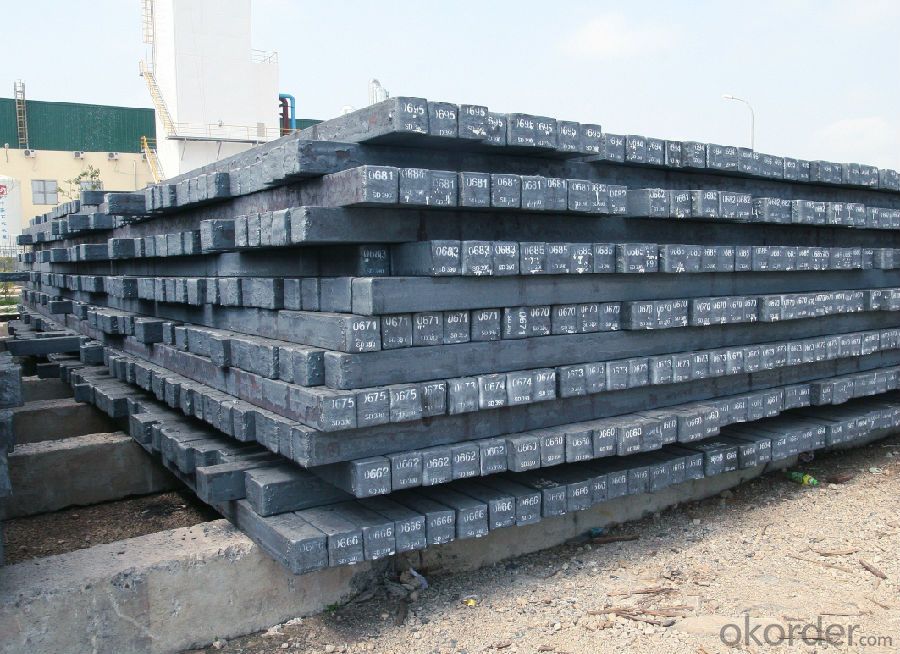
Main Feature of Hot Rolled Square Steel Billet 3SP Standard 175mm
1) Excellent corrosion resistance: The zinc layer provides a good protection of Pre-painted Galvanizeed Steel Sheet.
2) High heat resistance: The reflective surface of the material aids in efficiently reflecting the sunlight away and in turn reducing the amount of heat transmitted. The thermal reflectivity converts into energy savings.
3) Aesthetics: Pre-Painted Galvanized steel sheet is available in plethora of patterns and multiple sizes as per the requirements that given by our customers.
4) Versatility: can be used in the various areas.Standard seaworthy export packing: 3 layers of packing, inside is kraft paper, water plastic film is in the middle and outside GI steel sheet to be covered by steel strips with lock, with inner coil sleeve.
Applications of Hot Rolled Square Steel Billet 3SP Standard 175mm
1) Automotive bodies: filters, fuel tanks, etc.
2) Construction materials: roofings, welding pipes,
3) Electric and electronic appliances: computer cans, etc.
4) Steel cans: containers, etc.
5) Steel furniture: washing machines, refrigerators, microwaves, etc.
6) Drums
7) Office equipment: printer, recorders, etc.
8) Motors and transformers
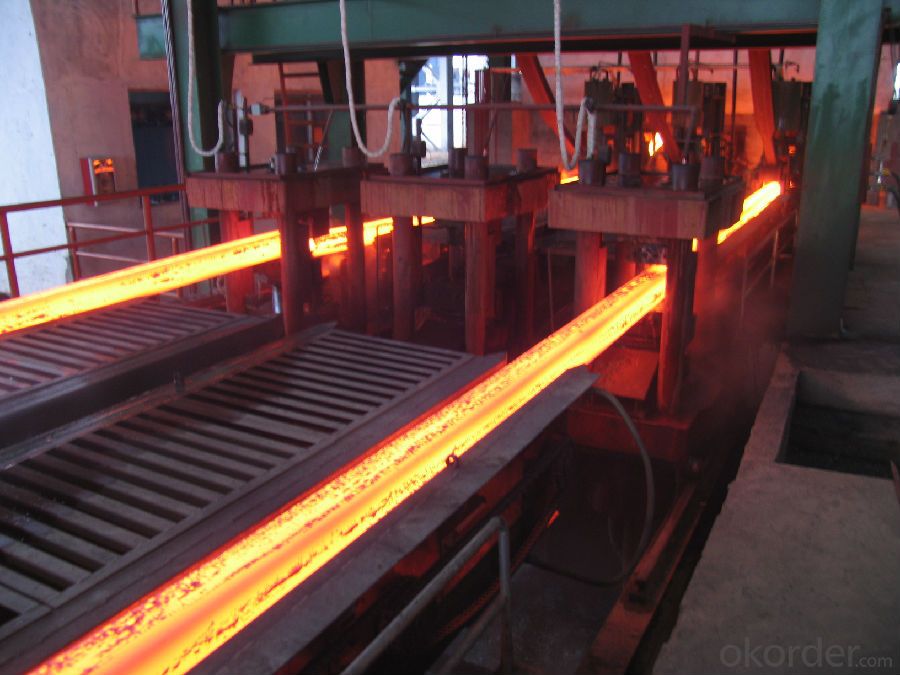
Specifications of Hot Rolled Square Steel Billet 3SP Standard 175mm
| Classified symbol | Yield Point Minimum N/mm2 | Tensile Strength Minimum | Elongation Minimum % | Application | ||||
| N/mm2 | Nominal Thickness mm (t) | |||||||
| JIS | Yogic | 0.25-0.4 | 0.4-0.6 | 0.6-1.0 | 1.0-1.6 | |||
| G3312 | specification | |||||||
| CGCC | CGCC | -205 | -270 | -20 | -21 | -24 | -24 | Commercial |
| CGCD | CGCD | --- | 270 | --- | 27 | 31 | 32 | Drawing |
| --- | CG340 | 245 | 340 | 20 | 20 | 20 | 20 | Structural |
| CGC400 | CG400 | 295 | 400 | 16 | 17 | 18 | 18 | Structural |
| CGC440 | CG440 | 335 | 440 | 14 | 15 | 16 | 18 | Structural |
| CGC490 | CG490 | 365 | 490 | 12 | 13 | 14 | 16 | Structural |
| CGC570 | CG570 | 560 | 570 | --- | --- | --- | --- | Structural |
| ASTM Designation | Yield Point Minimum | Tensile Strength Minimum | Elongation Minimum % | Application | Q/BQB 445-2004(China standard) | ASM A653/A653M | JISG 3312 | |
| ksi(MPa) | ksi(MPa) | TDC51D+Z | (CS TYPE A+Z) | CGCC | ||||
| A653(M)-99 CS TYPE A,B,C | --- | --- | --- | Commercial | TDC52D+Z | CGCD | ||
| A653(M)-99 FS | --- | --- | --- | Lock Forming | TS250GD+Z | (G250+Z) | - | |
| A653(M)-99 DS | --- | --- | --- | Drawing | TS300GS+Z | (G300+Z) | CGC 400 | |
| A653(M)-99 SS Grade33(230) | 33(230) | 45(310) | 20 | Structural | TS350GD+Z | (G350+Z) | CGC490 | |
| A653(M)-99 SS Grade37(255) | 37(255) | 52(360) | 18 | Structural | TS550GD+Z | (G550+Z) | CGC570 | |
| A653(M)-99 SS Grade40(275) | 40(275) | 55(380) | 16 | Structural | ||||
| A653(M)-99 SS Grade50(345) | 50(345) | 65(450) | 12 | Structural | ||||
| A653(M)-99 SS Grade80(550) | 80(550) | 82(570) | --- | Structural | ||||
FAQ of Hot Rolled Square Steel Billet 3SP Standard 175mm
We have organized several common questions for our clients,may help you sincerely:
1. How Can I Visit There?
Our company is located in Tianjin City, China, near Beijing. You can fly to Tianjin Airport Directly. All our clients, from home or aboard, are warmly welcome to visit us!
2. How Can I Get Some Sample?
We are honored to offer you sample.
3. Why choose CNBM?
1, ISO, BV, CE, SGS approved.
2, Competitive price and quality.
3, Efficient service team online for 24 hours.
4, Smooth production ability(50000tons/month) .
5, quick delivery and standard exporting package.
6, Flexible payment with T/T, L/C, Paypal, Kunlun bank, etc.
- Q:How are steel billets used in the production of valves?
- Steel billets are used in the production of valves as a raw material. They are melted and then shaped into the desired shape and size of the valve through various manufacturing processes such as forging, machining, and heat treatment. The steel billets provide the necessary strength and durability required for valves to withstand high pressure and temperature conditions.
- Q:How are steel billets different from steel bars?
- Steel billets and steel bars are both common forms of steel products used in various industries. However, there are some key differences between them. 1. Shape and Size: Steel billets are generally square or rectangular in shape and have larger cross-sectional areas compared to steel bars. They are typically produced in sizes ranging from 100x100mm to 150x150mm or larger. On the other hand, steel bars are available in various shapes such as round, square, flat, or hexagonal, and come in smaller sizes depending on their intended application. 2. Manufacturing Process: Steel billets are produced through a primary steelmaking process called continuous casting or ingot casting. In this process, molten steel is solidified into a semi-finished product, which is then further processed into steel bars or other forms. Steel bars, on the other hand, are produced through a secondary steelmaking process called hot rolling or cold drawing. This involves passing the steel billet through a series of rolling mills or drawing machines to achieve the desired shape and size. 3. Usage: Steel billets are primarily used as raw materials for the production of various steel products, including bars, rods, wire, pipes, and structural steel sections. They serve as a starting point for further processing and shaping. Steel bars, on the other hand, are the finished product that is used in construction, manufacturing, and other industries. They are commonly utilized in the production of reinforced concrete structures, automotive components, machinery parts, and tools. 4. Composition and Properties: Both steel billets and bars are made from carbon steel or alloy steel, but the specific composition and properties may vary depending on the desired end use. Steel billets are often made from low-carbon or mild steel, which provides good formability and weldability. Steel bars, on the other hand, can be made from a wide range of steel grades, including low carbon, medium carbon, and high carbon steels, as well as alloy steels. The choice of steel grade depends on the desired mechanical properties, such as strength, hardness, and ductility. In summary, steel billets are the semi-finished products used as raw materials for manufacturing steel bars and other steel products. They differ from steel bars in terms of shape, size, manufacturing process, usage, and composition.
- Q:How do steel billets contribute to the manufacturing of HVAC equipment?
- The manufacturing of HVAC equipment relies heavily on steel billets, which are essential components. These billets, created from molten steel and considered semi-finished products, play a vital role in the production process. To begin with, steel billets act as the raw material for various HVAC components like coils, pipes, and fittings. These components are fundamental for the proper functioning of HVAC systems, which depend on the circulation of air or refrigerant to regulate temperature. By providing the necessary strength and durability, steel billets ensure that these components can withstand the rigorous conditions within HVAC systems. Furthermore, steel billets allow for the creation of intricate shapes and structures needed in HVAC equipment. With their high tensile strength and malleability, steel billets can be easily molded and shaped into complex designs. This flexibility grants manufacturers the ability to produce customized HVAC equipment that meets specific requirements, whether it's for residential, commercial, or industrial use. Moreover, steel billets enhance the overall efficiency and lifespan of HVAC equipment. Thanks to their high thermal conductivity, steel components can efficiently transfer heat or cold, promoting effective temperature regulation. This aids HVAC systems in achieving optimal energy efficiency, reducing energy consumption and costs. Additionally, steel's resistance to corrosion ensures that HVAC equipment can endure exposure to various environmental factors, increasing their longevity and reliability. In conclusion, steel billets are of utmost importance in the manufacturing of HVAC equipment due to their role as raw material, flexibility in design, and durability. Their contributions ultimately result in the production of efficient, reliable, and long-lasting HVAC systems, benefiting both consumers and industries.
- Q:How are steel billets used in the production of shafts?
- Shafts require steel billets as an indispensable component for their production. These billets are semi-finished products that serve as the initial stage for diverse manufacturing processes. In the case of shaft production, steel billets serve as the raw material from which the shafts are formed. The process commences by heating the steel billets to a specific temperature, typically within a furnace. This heating procedure, referred to as "hot working," is of utmost importance as it renders the steel more pliable and easier to mold. Once the billet attains the desired temperature, it is subsequently transferred to either a forging press or a rolling mill. During the forging process, the heated billet undergoes high pressure and is shaped using specialized dies to achieve the desired dimensions for the shaft. This method permits precise control over the shape, size, and surface finish of the shaft. On the contrary, the rolling process entails the billet passing through a sequence of rollers that gradually shape it into a cylindrical form. Rolling is frequently employed for shafts necessitating a consistent cross-section along their length. Following the initial shaping process, the shafts go through additional steps such as heat treatment, machining, and finishing to fulfill the specific requirements of their intended applications. Heat treatment assists in enhancing the mechanical properties of the shaft, rendering it stronger, more durable, and resistant to wear. Subsequently, machining processes such as turning, milling, or grinding are conducted to achieve precise dimensions, smooth surfaces, and accurate tolerances. Altogether, steel billets occupy a pivotal role in the production of shafts as they serve as the starting point for the shaping processes imperative in creating these crucial components. Through meticulous manipulation and refinement, steel billets metamorphose into high-quality shafts utilized in a myriad of industries, including automotive, aerospace, manufacturing, and numerous others.
- Q:What are the different grades of steel used for producing billets?
- The different grades of steel used for producing billets vary depending on the specific requirements and applications. Some common grades include mild steel, low carbon steel, medium carbon steel, high carbon steel, alloy steel, and stainless steel. Each grade offers different mechanical properties, such as strength, durability, and corrosion resistance, to meet the desired characteristics for the final product.
- Q:How are steel billets marked for identification?
- Various techniques and methods are utilized to mark steel billets for identification. One common approach involves the use of marking stamps or dies, which contain specific alphanumeric characters or symbols that are pressed onto the billet's surface. This results in a permanent and visible mark that can be easily read and identified. Another method involves applying paint or ink to the surface of the billet, creating a distinct color or pattern. This mark can be visually inspected and compared to the corresponding identification code. In addition to manual methods, some steel billets are marked using laser engraving or etching. This precise technique utilizes a laser beam to remove a thin layer of material from the billet's surface, leaving a permanent identification mark. Laser marking is highly accurate and can produce detailed marks, including barcodes or QR codes that can be easily scanned for identification purposes. Furthermore, identification marks may be applied during the manufacturing process. These marks can include information such as steel grade, batch number, manufacturer's logo, or other relevant details. Hot stamping, embossing, or engraving techniques are commonly employed to ensure durability and visibility of these marks. Overall, a combination of manual techniques, such as marking stamps or paint marking, along with advanced methods like laser engraving or etching, are used to mark steel billets for identification. These identification marks play a vital role in traceability, quality control, and ensuring proper handling and usage of steel billets in various industrial applications.
- Q:What are the different surface treatments for improved fatigue resistance in steel billets?
- To enhance the fatigue resistance of steel billets, several surface treatments can be utilized. These treatments aim to improve the steel's fatigue strength by reducing crack formation and propagation, increasing resistance to cyclic loading conditions. Some common surface treatments include: 1. Shot peening: This technique involves bombarding the steel billets with small metallic or ceramic particles at high velocities. By inducing compressive residual stresses on the surface, crack initiation and propagation are prevented, thus improving fatigue resistance. 2. Nitriding: Through this heat treatment process, nitrogen is diffused into the surface layer of the steel billets. This creates a hard nitride layer, increasing hardness, wear resistance, and fatigue strength. 3. Carburizing: Carbon is diffused into the surface layer of the steel billets at high temperatures, increasing carbon content and forming a hardened layer. This enhances fatigue resistance and wear properties. 4. Shot peen forming: Controlled shot peening induces plastic deformation in the steel billets. This treatment improves fatigue resistance, as well as shape and dimensional stability. 5. Surface coatings: Protective coatings can be applied to the surface of steel billets to enhance fatigue resistance. Techniques such as electroplating, thermal spraying, and chemical vapor deposition can deposit wear-resistant and fatigue-enhancing coatings. It is important to consider specific application requirements, steel type, and desired fatigue improvement level when choosing a surface treatment. Thorough consideration and testing should be conducted to determine the most suitable technique for a particular application.
- Q:How do steel billets compare to other types of raw materials in manufacturing?
- Steel billets are widely recognized as one of the most versatile and commonly used raw materials in manufacturing industries. When compared to other types of raw materials, steel billets offer several advantages that make them highly desirable. Firstly, steel billets have exceptional strength and durability. This characteristic makes them suitable for a wide range of applications, including construction, automotive, and machinery manufacturing. Steel billets are known for their high tensile strength, which ensures the structural integrity of the final product. Secondly, steel billets have excellent heat resistance properties. This makes them ideal for applications that involve exposure to extreme temperatures, such as in the aerospace and energy sectors. Steel billets can withstand high temperatures without compromising their mechanical properties, ensuring the longevity and reliability of the manufactured products. Additionally, steel billets are highly malleable and can be easily shaped into various forms through processes like rolling, forging, or extrusion. This versatility allows manufacturers to create complex and intricate parts, components, and structures, meeting the diverse needs of different industries. Moreover, steel billets are readily available in large quantities, making them a cost-effective choice for manufacturing. The abundance of steel billets in the market ensures a stable supply chain and helps manufacturers avoid potential disruptions caused by material shortages. Lastly, steel billets are known for their recyclability, making them an environmentally friendly choice. Steel is one of the most recycled materials globally, and the use of steel billets in manufacturing contributes to reducing the environmental impact of waste disposal and conserving natural resources. In summary, steel billets outshine other types of raw materials in manufacturing due to their exceptional strength, heat resistance, malleability, cost-effectiveness, and recyclability. These qualities make steel billets a preferred choice for a wide range of industries, offering reliability, versatility, and sustainability in the manufacturing process.
- Q:How are steel billets used in the production of construction parts?
- Steel billets serve as a vital raw material for manufacturing construction parts. They are essentially semi-finished steel products that are cast into square or rectangular shapes. These billets undergo further processing to create various construction components, such as beams, columns, rods, and bars. To begin utilizing steel billets, they are first heated in a furnace to a temperature that allows for easy deformation and shaping. Once the billets reach the desired temperature, they are then passed through a series of rolling mills, where they undergo hot rolling. This process involves repeatedly passing the billets through multiple pairs of rollers to gradually reduce their size and shape them into the necessary form, such as beams or rods. Hot rolling not only shapes the billets but also enhances their mechanical properties, including strength, toughness, and ductility. After hot rolling, the resulting steel products are cut to the desired lengths and further processed, if required, to meet specific construction requirements. These steel components, derived from billets, are extensively used in construction projects. For example, beams made from steel billets are commonly employed to provide structural support in buildings and bridges. Due to their exceptional strength and load-bearing capacity, they are ideal for withstanding heavy loads and ensuring overall stability. Conversely, steel rods and bars find widespread use in reinforced concrete construction. These components are embedded within the concrete to enhance its tensile strength and prevent the formation of cracks. They play a vital role in constructing foundations, slabs, walls, and other structural elements that require additional reinforcement. In conclusion, steel billets are of immense importance in the production of construction parts, serving as the starting point for the manufacturing process. Through hot rolling and subsequent processing, these billets are transformed into various steel components that provide structural support, reinforcement, and durability in construction projects.
- Q:Can steel billets be used in the production of energy-efficient appliances?
- Certainly, energy-efficient appliances can make use of steel billets. Steel, being a versatile material renowned for its strength and durability, is extensively employed in appliance manufacturing. These appliances are designed to minimize energy consumption and greenhouse gas emissions by employing less energy while performing their designated tasks. When it comes to energy-efficient appliances, steel billets can be processed and transformed into numerous components, including outer shells, structural supports, and internal parts. The incorporation of steel ensures the longevity and dependability of these appliances, thereby enhancing their overall energy efficiency. Moreover, steel is highly recyclable, allowing it to be repurposed or reused for other applications once an appliance reaches the end of its lifecycle. Steel recycling aids in energy conservation and waste reduction, further bolstering the pursuit of energy efficiency. To summarize, the utilization of steel billets is indeed feasible in the production of energy-efficient appliances. The exceptional properties of steel, namely its strength, durability, and recyclability, make it an ideal choice for manufacturing appliances that promote a more sustainable future.
1. Manufacturer Overview |
|
|---|---|
| Location | |
| Year Established | |
| Annual Output Value | |
| Main Markets | |
| Company Certifications | |
2. Manufacturer Certificates |
|
|---|---|
| a) Certification Name | |
| Range | |
| Reference | |
| Validity Period | |
3. Manufacturer Capability |
|
|---|---|
| a)Trade Capacity | |
| Nearest Port | |
| Export Percentage | |
| No.of Employees in Trade Department | |
| Language Spoken: | |
| b)Factory Information | |
| Factory Size: | |
| No. of Production Lines | |
| Contract Manufacturing | |
| Product Price Range | |
Send your message to us
Hot Rolled Square Steel Billet 3SP Standard 175mm
- Loading Port:
- Shanghai
- Payment Terms:
- TT OR LC
- Min Order Qty:
- 2000 m.t.
- Supply Capability:
- 10000 m.t./month
OKorder Service Pledge
OKorder Financial Service
Similar products
New products
Hot products
Hot Searches
Related keywords
